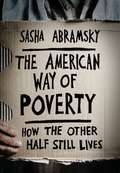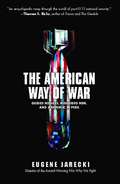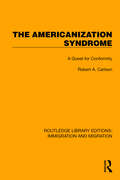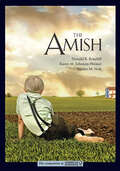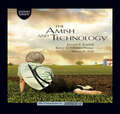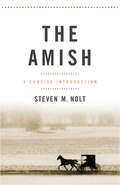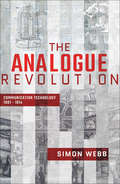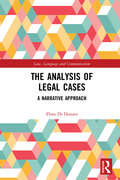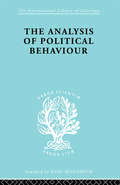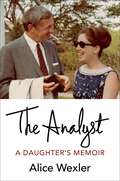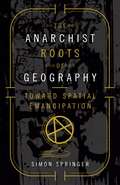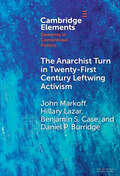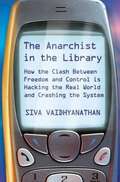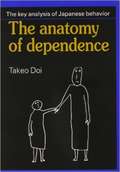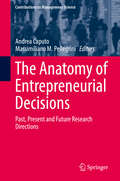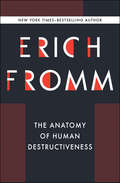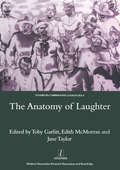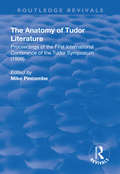- Table View
- List View
The American Urban Reader: History and Theory
by Steven H. Corey Lisa Krissoff BoehmThe American Urban Reader brings together the most exciting work on the evolution of the American city, from colonial settlement and western expansion to post-industrial cities and the growth of the suburbs. Each of the chronologically and thematically organized chapters includes thoughtfully selected scholarly essays from historians, social scientists and journalists, which are supplemented by relevant primary documents that offer more nuanced perspectives and convey the diversity and interdisciplinary nature of the study of the urban condition.
The American Way of Poverty: How the Other Half Still Lives
by Sasha AbramskySelected as A Notable Book of the Year by " The New York Times Book Review" Fifty years after Michael Harrington published his groundbreaking book "The Other America," in which he chronicled the lives of people excluded from the Age of Affluence, poverty in America is back with a vengeance. It is made up of both the long-term chronically poor and new working pooruthe tens of millions of victims of a broken economy and an ever more dysfunctional political system. In many ways, for the majority of Americans, financial insecurity has become the new norm. "The American Way of Poverty" shines a light on this travesty. Sasha Abramsky brings the effects of economic inequality out of the shadows and, ultimately, suggests ways for moving toward a fairer and more equitable social contract. Exploring everything from housing policy to wage protections and affordable higher education, Abramsky lays out a panoramic blueprint for a reinvigorated political process that, in turn, will pave the way for a renewed War on Poverty. It is, Harrington believed, a moral outrage that in a country as wealthy as America, so many people could be so poor. Written in the wake of the 2008 financial collapse, in an era of grotesque economic extremes, "The American Way of Poverty" brings that same powerful indignation to the topic. "
The American Way of War: Guided Missiles, Misguided Men, and a Republic in Peril
by Eugene JareckiIn the sobering aftermath of America's invasion of Iraq, Eugene Jarecki launches a penetrating and revelatory inquiry into how forces within the American political, economic, and military systems have come to undermine the carefully crafted structure of our republic -- upsetting its balance of powers, vastly strengthening the hand of the president in taking the nation to war, and imperiling the workings of American democracy. This is a story not of simple corruption but of the unexpected origins of a more subtle and, in many ways, more worrisome disfiguring of our political system and society. While in no way absolving George W. Bush and his inner circle of their accountability for misguiding the country into a disastrous war -- in fact, Jarecki sheds new light on the deepest underpinnings of how and why they did so -- he reveals that the forty-third president's predisposition toward war and Congress's acquiescence to his wishes must be understood as part of a longer story. This corrupting of our system was predicted by some of America's leading military and political minds. In his now legendary 1961 farewell address, President Dwight D. Eisenhower warned of "the disastrous rise of misplaced power" that could result from the increasing influence of what he called the "military industrial complex. " Nearly two centuries earlier, another general turned president, George Washington, had warned that "overgrown military establishments" were antithetical to republican liberties. Today, with an exploding defense budget, millions of Americans employed in the defense sector, and more than eight hundred U. S. military bases in 130 countries, the worst fears of Washington and Eisenhower have come to pass. Surveying a scorched landscape of America's military adventures and misadventures, Jarecki's groundbreaking account includes interviews with a who's who of leading figures in the Bush administration, Congress, the military, academia, and the defense industry, including Republican presidential nominee John McCain, Colin Powell's former chief of staff Colonel Lawrence Wilkerson, and longtime Pentagon reformer Franklin "Chuck" Spinney. Their insights expose the deepest roots of American war making, revealing how the "Arsenal of Democracy" that crucially secured American victory in WWII also unleashed the tangled web of corruption America now faces. From the republic's earliest episodes of war to the use of the atom bomb against Japan to the passage of the 1947 National Security Act to the Cold War's creation of an elaborate system of military-industrial-congressional collusion, American democracy has drifted perilously from the intent of its founders. As Jarecki powerfully argues, only concerted action by the American people can, and must, compel the nation back on course. The American Way of War is a deeply thought-provoking study of how America reached a historic crossroads and of how recent excesses of militarism and executive power may provide an opening for the redirection of national priorities.
The Americanization Syndrome: A Quest for Conformity (Routledge Library Editions: Immigration and Migration #3)
by Robert A. CarlsonThe Americanization Syndrome (1987) examines the historical role of education in the process of ‘Americanization’. It argues that beginning with seventeenth century puritan leaders such as John Winthrop and Cotton Maher, the pattern of American education has been not the promotion of a blend of different cultures but the indoctrination of norms of belief of religion, politics and economics and an explicit discouragement of cultural variety. It traces the political role of education at key junctures of American history – after Independence, in the reconstruction of the South after the Civil War, in the establishment of settlement houses and the use of scientific management techniques by employers. The author focuses on the period 1900–1925 when new waves of immigrants from southern and eastern Europe led to a new drive for orthodoxy.
The Americanization of Narcissism
by Elizabeth LunbeckAmerican social critics in the 1970s, convinced that their nation was in decline, turned to psychoanalysis for answers and seized on narcissism as the sickness of the age. Books indicting Americans as greedy, shallow, and self-indulgent appeared, none more influential than Christopher Lasch's famous 1978 jeremiad "The Culture of Narcissism. " This line of critique reached a crescendo the following year in Jimmy Carter's "malaise speech" and has endured to this day. But as Elizabeth Lunbeck reveals, the American critics missed altogether the breakthrough in psychoanalytic thinking that was championing narcissism's positive aspects. Psychoanalysts had clashed over narcissism from the moment Freud introduced it in 1914, and they had long been split on its defining aspects: How much self-love, self-esteem, and self-indulgence was normal and desirable? While Freud's orthodox followers sided with asceticism, analytic dissenters argued for gratification. Fifty years later, the Viennese emigre Heinz Kohut led a psychoanalytic revolution centered on a "normal narcissism" that he claimed was the wellspring of human ambition, creativity, and empathy. But critics saw only pathology in narcissism. The result was the loss of a vital way to understand ourselves, our needs, and our desires. Narcissism's rich and complex history is also the history of the shifting fortunes and powerful influence of psychoanalysis in American thought and culture. Telling this story, The Americanization of Narcissism" ultimately opens a new view on the central questions faced by the self struggling amid the tumultuous crosscurrents of modernity.
The Amish
by Steven M. Nolt Donald B. Kraybill Karen M. Johnson-WeinerCompanion to the acclaimed PBS American Experience documentary.Winner of the CHOICE Outstanding Academic Title of the Choice ACRLThe Amish have always struggled with the modern world. Known for their simple clothing, plain lifestyle, and horse-and-buggy mode of transportation, Amish communities continually face outside pressures to modify their cultural patterns, social organization, and religious world view. An intimate portrait of Amish life, The Amish explores not only the emerging diversity and evolving identities within this distinctive American ethnic community, but also its transformation and geographic expansion.Donald B. Kraybill, Karen M. Johnson-Weiner, and Steven M. Nolt spent twenty-five years researching Amish history, religion, and culture. Drawing on archival material, direct observations, and oral history, the authors provide an authoritative and sensitive understanding of Amish society. Amish people do not evangelize, yet their numbers in North America have grown from a small community of some 6,000 people in the early 1900s to a thriving population of more than 320,000 today. The largest populations are found in Ohio, Pennsylvania, and Indiana, with additional communities in twenty-eight other states and three Canadian provinces. The authors argue that the intensely private and insular Amish have devised creative ways to negotiate with modernity that have enabled them to thrive in America. The transformation of the Amish in the American imagination from "backward bumpkins" to media icons poses provocative questions. What does the Amish story reveal about the American character, popular culture, and mainstream values? Richly illustrated, The Amish is the definitive portrayal of the Amish in America in the twenty-first century.
The Amish and Technology: An Excerpt from The Amish
by Steven M. Nolt Donald B. Kraybill Karen M. Johnson-WeinerHopkins Digital Shorts deliver high-quality scholarship and compelling narratives in an abbreviated, electronic format. Whether excerpted from forthcoming or classic backlist titles or developed with newly commissioned content, Hopkins Digital Shorts provide concise introductions to fundamental concepts, defining moments, and influential texts.Limits on technology are the signature mark of twenty-first century Amish identity. Riding in horse-drawn buggies and living unplugged from the public grid unmistakably separate Amish people from mainstream Americans. Yet the Amish do not categorically condemn technology. Nor are they technologically naïve. Rather, Amish communities selectively sort out what might help or harm them. More significantly, the Amish modify and adapt technology in creative ways to fit their cultural values and social goals. Amish technologies are diverse, complicated, and ever-changing. This digital short explores the complicated relationship between the Amish and technology today.
The Amish: A Concise Introduction (Young Center Books in Anabaptist and Pietist Studies)
by Steven M. NoltThe essential introduction to Amish life and culture.There seems to be no end to our fascination with the Amish, a religious minority that has both placed itself outside the mainstream of American culture and flourished within it. Yet most people know very little about the nuanced relationship the Amish have with society or their own communities. Drawing on more than twenty years of fieldwork and collaborative research, Steven M. Nolt’s The Amish: A Concise Introduction is a compact but richly detailed portrait of Amish life. In fewer than 150 pages, readers will come away with a clear understanding of the complexities of these simple people. Writing in engaging and accessible language, Nolt explains how the Amish at once operate within modern America and stand very much apart from the world. Arguing that Amish life is shaped equally by internal and external social, political, and economic contexts, Nolt explores Amish identity as emerging from a complex cultural negotiation with modernity. He takes on much-hyped topics such as Rumspringa and reveals the distinctive Amish approach to technology. He also explains how Amish principles stand in contrast to contemporary American values, including rational efficiency, large-scale organization, and Western notions of individuality. Authoritative, informative, and illustrated, this guide provides a vivid introduction to a way of life many find fascinating but few truly understand.
The Analogue Revolution: Communication Technology, 1901–1914
by Simon WebbWe are all familiar with the digital revolution that has swept across the developed world in recent years. It has ushered in an age of smartphones, laptop computers and ready access to the internet. A little over a century ago, a similar explosion took place in the field of information and communication technology. This revolution was not digital but analogue, and it saw the birth of mass media such as newspapers, cinema and radio.In The Analogue Revolution, Simon Webb examines the impact that developments in printing, photography, wireless telegraphy, gramophones and moving pictures had in the years preceding the First World War, and shows how the modern world was shaped by the media used to record it. From the first mass-circulation newspapers to cameras so cheap that everybody could afford them, from early experiments in radio broadcasting to cinema films in color, The Analogue Revolution charts the history of the first information revolution of the twentieth century. The parallels with the modern world are uncanny, ranging from anxiety about the use of new technology to distribute pornography, to worries about children losing interest in reading because they prefer to watch films.For anybody wishing to understand the modern world, this book is an essential primer in the nature of information revolutions and the way in which they affect the world.
The Analysis of Legal Cases: A Narrative Approach (Law, Language and Communication)
by Flora Di DonatoThis book examines the roles played by narrative and culture in the construction of legal cases and their resolution. It is articulated in two parts. Part I recalls epistemological turns in legal thinking as it moves from theory to practice in order to show how facts are constructed within the legal process. By combining interdisciplinary paradigms and methods, the work analyses the evolution of facts from their expression by the client to their translation within the lawyer-client relationship and the subsequent decision of the judge, focusing on the dynamic activity of narrative constuction among the key actors: client, lawyer and judge. Part II expands the scientific framework toward a law-and-culture-oriented perspective, illustrating how legal stories come about in the fabric of the authentic dimensions of everyday life. The book stresses the capacity of laypeople, who in this activity are equated with clients, to shape the law, dealing not just with formal rules, but also with implicit or customary rules, in given contexts. By including the illustration of cases concerning vulnerable clients, it lays the foundations for developing a socio-clinical research programme, whose aims including enabling lay and expert actors to meet for the purposes of improving forms of collective narrations and generating more just legal systems.
The Analysis of Political Behaviour (International Library of Sociology)
by Harold D. LasswellFirst published in 1998. Routledge is an imprint of Taylor & Francis, an informa company.
The Analysis of Political Systems (International Library of Sociology)
by Douglas V. VerneyPublished in 1998, The Analysis of Political Systems is a valuable contribution to the field of Sociology & Social Policy.
The Analyst in the Inner City, Second Edition: Race, Class, and Culture Through a Psychoanalytic Lens (Relational Perspectives Book Series)
by Neil AltmanIn 1995, Neil Altman did what few psychoanalysts did or even dared to do: He brought the theory and practice of psychoanalysis out of the cozy confines of the consulting room and into the realms of the marginalized, to the very individuals whom this theory and practice often overlooked. In doing so, he brought together psychoanalytic and social theory, and examined how divisions of race, class and culture reflect and influence splits in the developing self, more often than not leading to a negative self image of the "other" in an increasingly polarized society.<P><P> Much like the original, this second edition of The Analyst in the Inner City opens up with updated, detailed clinical vignettes and case presentations, which illustrate the challenges of working within this clinical milieu. Altman greatly expands his section on race, both in the psychoanalytic and the larger social world, including a focus on "whiteness" which, he argues, is socially constructed in relation to "blackness." However, he admits the inadequacy of such categorizations and proffers a more fluid view of the structure of race. A brand new section, "Thinking Systemically and Psychoanalytically at the Same Time," examines the impact of the socio-political context in which psychotherapy takes place, whether local or global, on the clinical work itself and the socio-economic categories of its patients, and vice-versa. Topics in this section include the APA’s relationship to CIA interrogation practices, group dynamics in child and adolescent psychotherapeutic interventions, and psychoanalytic views on suicide bombing.<P> Ranging from the day-to-day work in a public clinic in the South Bronx to considerations of global events far outside the clinic’s doors (but closer than one might think), this book is a timely revision of a groundbreaking work in psychoanalytic literature, expanding the import of psychoanalysis from the centers of analytical thought to the margins of clinical need.
The Analyst: A Daughter's Memoir
by Alice WexlerMilton Wexler was among the most unconventional, compelling, and sometimes controversial figures of the golden age of psychoanalysis in America. From Teachers College at Columbia University to the Menninger Foundation in Topeka to the galleries and gilded hills of Hollywood, he traversed the country and the century, pursuing interests ranging from the treatment of schizophrenia to group therapy with artists to advocacy for research on Huntington’s disease. At a time when psychologists and psychoanalysts tended to promote adjustment to society, Wexler increasingly championed creativity and struggle.The Analyst is an intimate and searching portrait of Milton Wexler, written by his daughter, an acclaimed historian. Alice Wexler illuminates her father’s intense private life and explores how his life and work reveal the broader reaches of Freudian ideas in the United States. She draws on decades of Milton Wexler’s unpublished family and professional correspondence and manuscripts as well as her own interviews, diaries, and memories. Through the lens of Milton Wexler’s friendships, the book offers glimpses into the lives of cultural icons such as Lillian Hellman, Eppie Lederer (Ann Landers), and Frank Gehry. The Analyst is at once a striking account of the arc of an iconoclast’s life, a daughter’s moving meditation on her complex father, and a new window onto on the wider landscape of psychoanalysis and science in the twentieth century.
The Anarchist Roots of Geography: Toward Spatial Emancipation
by Simon SpringerThe Anarchist Roots of Geography sets the stage for a radical politics of possibility and freedom through a discussion of the insurrectionary geographies that suffuse our daily experiences. By embracing anarchist geographies as kaleidoscopic spatialities that allow for nonhierarchical connections between autonomous entities, Simon Springer configures a new political imagination.Experimentation in and through space is the story of humanity&’s place on the planet, and the stasis and control that now supersede ongoing organizing experiments are an affront to our survival. Singular ontological modes that favor one particular way of doing things disavow geography by failing to understand the spatial as a mutable assemblage intimately bound to temporality. Even worse, such stagnant ideas often align to the parochial interests of an elite minority and thereby threaten to be our collective undoing. What is needed is the development of new relationships with our world and, crucially, with each other. By infusing our geographies with anarchism we unleash a spirit of rebellion that foregoes a politics of waiting for change to come at the behest of elected leaders and instead engages new possibilities of mutual aid through direct action now. We can no longer accept the decaying, archaic geographies of hierarchy that chain us to statism, capitalism, gender domination, racial oppression, and imperialism. We must reorient geographical thinking towards anarchist horizons of possibility. Geography must become beautiful, wherein the entirety of its embrace is aligned to emancipation.
The Anarchist Turn in Twenty-First Century Leftwing Activism: The Anarchist Turn In Twenty-first Century Leftwing Activism (Elements in Contentious Politics)
by John Markoff Hillary Lazar Benjamin S. Case Daniel P. BurridgeLeftwing activism of recent decades exhibits an anarchist turn evident in quantitative indicators like mentions of anarchists in news reports and by activists adopting anarchist modes of organization, tactics, and social goals-whether or not they claim that label. The authors of this Element argue that the very crises that generated radical mobilizations since the turn of the millennium have both led activists to reject other strategies for social transformation and to see anarchist practices as appropriate to the challenges of our time. This turn is clearly apparent in the Americas and Europe, and has reverberations on an even broader transnational, perhaps global, scale. This suggests the need for research on social movements to consider anarchists and other marginalized radical traditions more fully, not just as objects of study, but as important sources of theory.
The Anarchist in the Library: How the Clash Between Freedom and Control Is Hacking the Real World and Crashing the System
by Siva VaidhyanathanThis relatively brief book tackles an expansive topic: Internet technology and its effect on our social, political and cultural future. For cultural historian and media scholar Vaidhyanathan (Copyrights and Copywrongs), the digital revolution is about far more than downloading music. Weaving an array of historical examples with prescient analysis, Vaidhyanathan takes the Internet battles common to most readers today-e.g., the well-publicized efforts of the recording industry to stop file-sharing; the practices of those who share music online-to craft a treatise on how technology highlights the eternal cultural struggle between "oligarchy and anarchy."
The Anatomy of Adolescence: Young people's social attitudes in Britain (Psychology Revivals)
by Adrian Furnham Barrie GunterOriginally published in 1989, this is a unique reference source to the social attitudes of British adolescents of the time. The authors, both experienced researchers, draw on a sample of over 2,000 adolescents from all over the British Isles, including Northern Ireland and the north of Scotland as well as the south of England and Wales. They provide one of the most comprehensive reviews of the 1980s, with the results summarized in tables supported by clear commentaries. The contents range widely over key issues of the time, covering attitudes to politics and government, crime and law enforcement, sex roles and race, religion and the paranormal, health and the environment, school, work and unemployment, and home entertainment media. Some of the book’s findings are unexpected: young people are surprisingly conservative about the role of men and women, for instance, yet they have radical ideas about certain institutions, like the monarchy. Altogether the book gives a clear and revealing snapshot of the attitudes of young Britons of the time.
The Anatomy of Dependence
by John Bester Takeo DoiPublished in Japan as Amae no Kozo (The Structure of Amae), Dr. Doi's work is focused upon the word "amae" (indulgence) and its related vocabulary. Expressive of an emotion central to the Japanese experience, "amae" refers to the indulging, passive love which surrounds and supports the individual in a group, whether family, neighborhood, or the world at large. Considering the lack of such words in Western languages, Dr. Doi suggests inherent differences between the two cultures-contrasting the ideal of self-reliance with those of interdependence and the indulgence of weaknesses. Yet, he finds that Western audiences have no difficulty in recognizing and identifying with the emotions he describes, and are even searching for a way to express this need.
The Anatomy of Entrepreneurial Decisions: Past, Present and Future Research Directions (Contributions to Management Science)
by Andrea Caputo Massimiliano M. PellegriniThe creation, success and long-term survival of enterprises are fundamentally linked to the effectiveness of decision-making processes and negotiation capabilities. This book provides an overview of research into how decisions permeate entrepreneurial ventures throughout their lifecycle. A multidisciplinary approach combining psychology, sociology and political science is used to investigate how entrepreneurs address and deal with decision-making. The respective contributions highlight the latest empirical, theoretical and meta-research, and bridge the gap between literature on entrepreneurship, entrepreneurial and innovative behaviours with that on decision-making and negotiation. This book is one of the first to combine these streams of research, thereby offering a new and insightful addition to the field of entrepreneurship.
The Anatomy of Human Destructiveness: Escape From Freedom, To Have Or To Be?, And The Anatomy Of Human Destructiveness (Pelican Ser.)
by Erich FrommA study of aggression from the renowned social psychologist and New York Times–bestselling author of The Art of Loving and Escape from Freedom. Throughout history, humans have shown an incredible talent for destruction as well as creation. Aggression has driven us to great heights and brutal lows. In The Anatomy of Human Destructiveness, renowned social psychologist Erich Fromm discusses the differences between forms of aggression typical for animals and two very specific forms of destructiveness that can only be found in human beings: sadism and necrophilic destructiveness. His case studies span zoo animals, necrophiliacs, and the psychobiographies of notorious figures such as Adolf Hitler and Joseph Stalin. Through his broad scholarship, Fromm offers a comprehensive exploration of the human impulse for violence. This ebook features an illustrated biography of Erich Fromm including rare images and never-before-seen documents from the author&’s estate.
The Anatomy of Laughter
by Toby Garfitt"The nature of laughter has recently attracted the attention of a number of different disciplines. In two recent colloquia, TRIO (Translation Research in Oxford) brought together international authorities from fields as diverse as physiology, psychology, linguistics, translation and literary studies, and sociology, with scant regard for political correctness. This fascinating and often hilarious collection of essays is the result. With the contributions: Jane Taylor - Introduction Dominique Bertrand - Anatomie et etymologie: ordre et desordre du rire selon Laurent Joubert Silke Kipper, Dietmar Todt - The Sound of Laughter: Recent Concepts and Findings in Research into Laughter Vocalizations Sarah-Jayne Blakemore - Why Can't You Tickle Yourself? Michael Holland - Belly Laughs Walter Redfern - Upping the Ante/i: Exaggeration in Celine and Valles Giselinde Kuipers - Humour Styles and Class Cultures: Highbrow Humour and Lowbrow Humour in the Netherlands Christie Davies - Searching for Jokes: Language, Translation, and the Cross-Cultural Comparison of Humour Ted Cohen - And What If They Don't Laugh? Iain Galbraith - Without the Rape the Talk-Show Would Not Be Laughable Jean-Michel Deprats - Translating a Great Feast of Languages Paul J. Memmi - Traduire le rire Natacha Thiery - Rire et desir dans les comedies americaines de Lubitsch: l'exemple de Ninotchka (1939) Adam Phillips - What's So Funny? On Being Laughed at ...Sukanta Chaudhuri - Laughing and Talking Georges Roque - Le Rire comme accident en peinture Laurent Bazin - La Couleur du rire: peinture et traduction Gerard Toulouse - Views on the Physics and Metaphysics of Laughter"
The Anatomy of Power
by John Kenneth GalbraithA critical analysis of power by renowned author John Kenneth Galbraith, where he discusses its origins and manifestations, and culminates in a discussion of the response to power in a largely democratic context.
The Anatomy of Tudor Literature: Proceedings of the First International Conference of the Tudor Symposium (1998) (Routledge Revivals)
by Mike PincombeThis title was first published in 2001. Is there such a thing as "Tudor literature"? The question is the theme that binds the essays in this collection. Scholars from around the world address the question of whether there is a sense of continuity in the literature of the Tudor century. The volume begins by looking at early Tudor writers, such as Thomas More, and then moves on to look at Elizabethan poetry and prose, ending by covering the late Tudor dramas, and Shakespeare.

